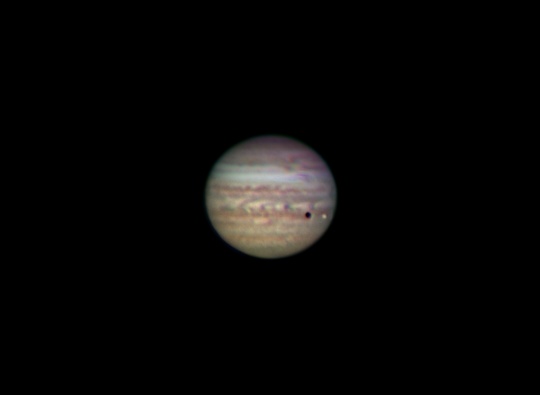
Jupiter is more massive than all of the other planets and their moons combined. Jupiter is believed to be a huge, rapidly spinning, liquid ball topped by a thick atmosphere made mostly of hydrogen and helium. The atmosphere also contains traces of methane, water vapor, sulfur compounds, phosphorous compounds, and ammonia. Jupiter's atmosphere is dynamic with changing cloud features and convoluted weather patterns and storms. The dark areas are believed to be portions of the atmosphere that are cooler, and are descending, while the lighter areas are believed to be warmer gasses that are rising. Jupiter's famous great red spot is a colossal atmospheric storm that has been raging on Jupiter for over 300 years. This image shows Jupiter's moon Io and the moon's shadow both transiting across the face of the planet.
Like Saturn, Jupiter has lightning and auroral emissions. Jupiter also has rings like Saturn. However, Jupiter's rings are very thin and faint, and the rings are not visible from Earth. Jupiter radiates about twice as much heat as it receives from the Sun. At the time this image was taken, Jupiter was 45 arc-seconds in diameter, and at magnitude -2.6, was the brightest object in the sky.
This is an RGB composite CCD image taken with an FLI IMG6303e CCD on the Steward Observatory 61-inch Kuiper Telescope. Adam Block is conducting a nightly observing program at the Mount Lemmon SkyCenter run by the University of Arizona that is open to the public. You can view and understand the night sky with an expert astronomer to guide you on an adventure under the stars using a state-of-the-art RCOS 24-inch telescope, and some of the astronomy camps offer opportunities to observe with the 61-inch Kuiper Telescope. I highly recommend the public outreach programs at the Mount Lemmon SkyCenter.
Jupiter
Constellation: Ophiuchus
RA: 17h 10m 49.7s Dec: -15d 44' 12.3"
May 24, 2007
Image by Sid Leach and Wil Milan
Mt. Bigelow, Arizona
Recent Images.
Complete list of images.
Description of equipment used to acquire images.
Home
Feedback and comments should go to Sid